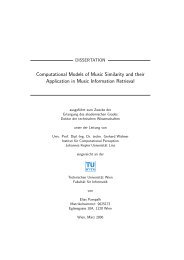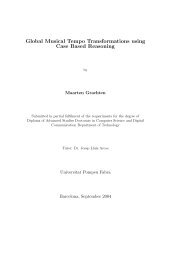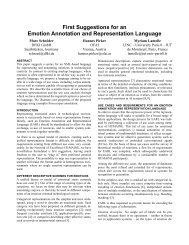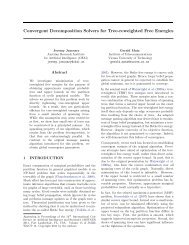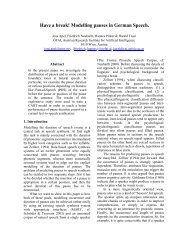A HYBRID MODEL OF REASONING BY ANALOGY
A HYBRID MODEL OF REASONING BY ANALOGY
A HYBRID MODEL OF REASONING BY ANALOGY
You also want an ePaper? Increase the reach of your titles
YUMPU automatically turns print PDFs into web optimized ePapers that Google loves.
of connectivity of the element in question with all other elements of that context. This criterion is<br />
based on the reasoner's implicit assumption that things that happen simultaneously are probably<br />
causally related (which forces a tendency to link co-occuring events or features). This is not always<br />
true, but it provides a criterion for relevance that is both dynamic and easy to test. I call this<br />
associative relevance.<br />
Why do we need both types of relevance? In an artificial situation where only the problem<br />
description forms the context, e.g. where the list of all possible actions and/or instruments is<br />
provided for in the problem description, it is possible, at least theoretically, to test the causal<br />
relevance of each action or instrument. In a realistic context, however, the reasoner has to elicit the<br />
possible actions from memory and the possible instruments from the real-world environment. Thus<br />
it is impossible simply to test all the possibilities since explicit knowledge about most (or all) of<br />
them will be unavailable a priori.<br />
People, however, have an intuitive idea of the important aspects of a situation even before there is<br />
any possibility of formal analysis of the situation and sometimes even before the goals are defined<br />
or made explicit. In other words, the reasoner will know that a particular element is somehow<br />
connected to other pieces of knowledge, presently considered as relevant, without being able to<br />
report the exact nature of these connections or a particular path followed. In this way associative<br />
relevance can be considered as a preliminary and approximate estimation of the relevance of all<br />
memory elements to the whole context. Only the ones estimated as most relevant are eventually<br />
tested for their causal relevance, i.e. for their particular relevance to the goal of the reasoner.<br />
Let us recall some famous examples where the particular external context has reportedly played a<br />
crucial role in human reasoning:<br />
- Archimedes discovered his law in the bathroom seeing the water overflowing the bath when<br />
he entered it;<br />
- seeing an apple falling from a tree gave Newton inspiration for his theory of gravity;<br />
- John Atanassov (one of the inventors of digital computers) decided to use electronic tubes<br />
for his computer when he saw a row of bottles in a bar.<br />
In all those cases it was the particular external context which made the corresponding memory<br />
elements associatively relevant and only then a more formal analysis elucidated the causal relations<br />
(if any) between the perceived event and the goal of the reasoners. Formal analysis of all events<br />
perceived from the environment was definitely not performed; only those "felt" to be relevant were<br />
formally analyzed.<br />
On the other hand, the priming effects demonstrated in our experiments manifest the influence of<br />
the particular internal context on the associative relevance of memory elements and thus on the line<br />
of reasoning.<br />
Differences between causal and associative rele vance. The two types of relevance considered above<br />
seem to have very different properties (Table 3). For example, causal relevance appears to be more<br />
static since it depends on the problem goal and is thus highly connected to the problem itself, i.e.<br />
whenever we present one and the same problem, the same elements are expected to be considered<br />
important as they will always be connected to the goal of the problem. 1 On the contrary, associative<br />
relevance is highly dynamic and variable because of the continuously developing external and<br />
internal contexts (note that it is impossible to replicate any particular context). This throws light on<br />
the causes for the variability of human problem solving behavior and in particular - for the priming<br />
effects demonstrated in section 2.2.<br />
1<br />
However, since the finding of a causal path can depend on its associative relevance, causal<br />
relevance can also be considered as dynamic and context-dependent.




